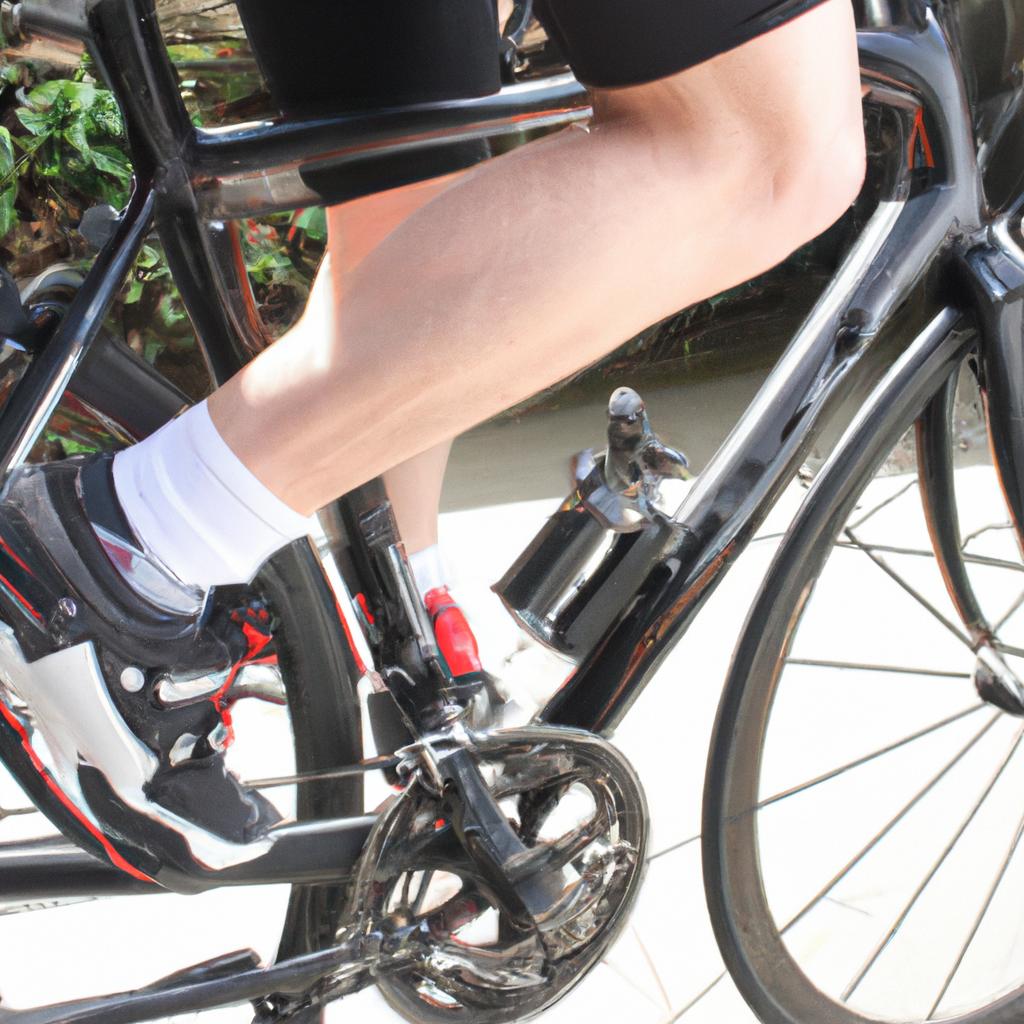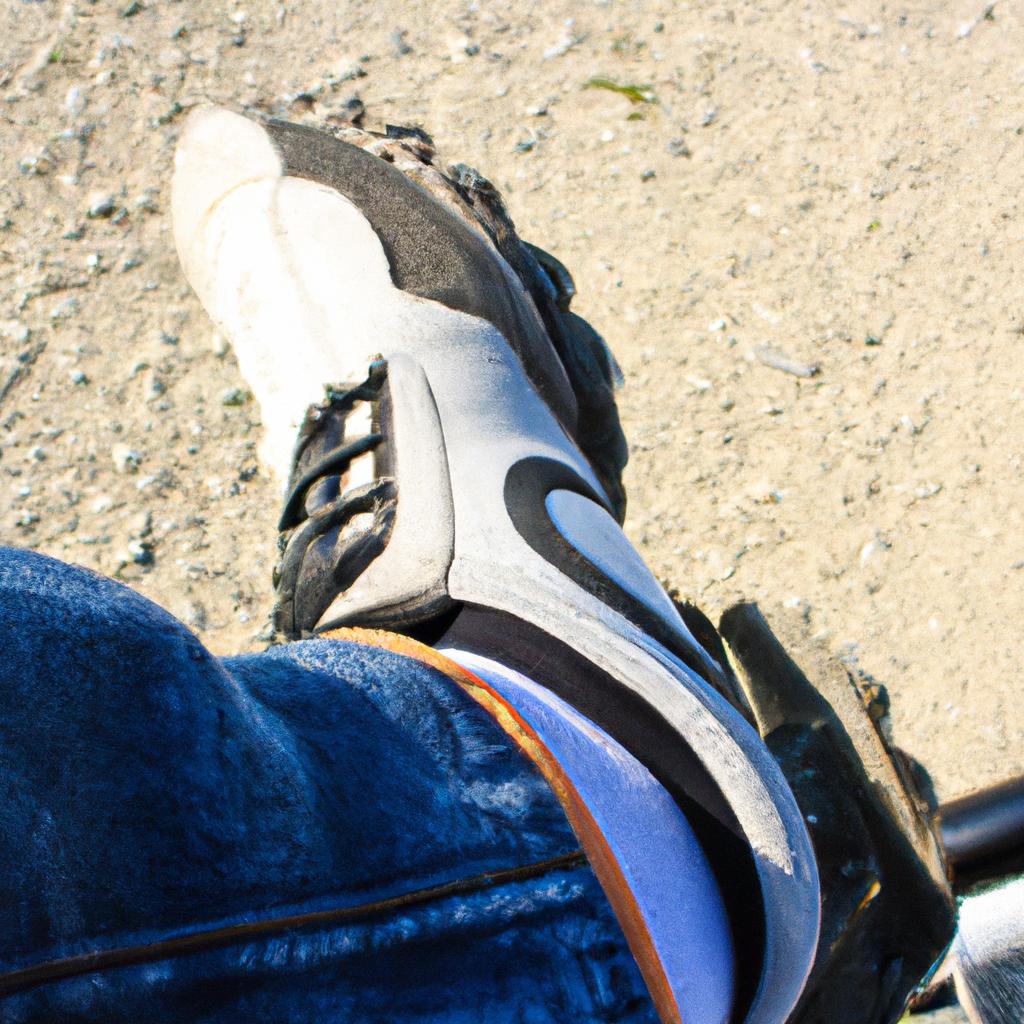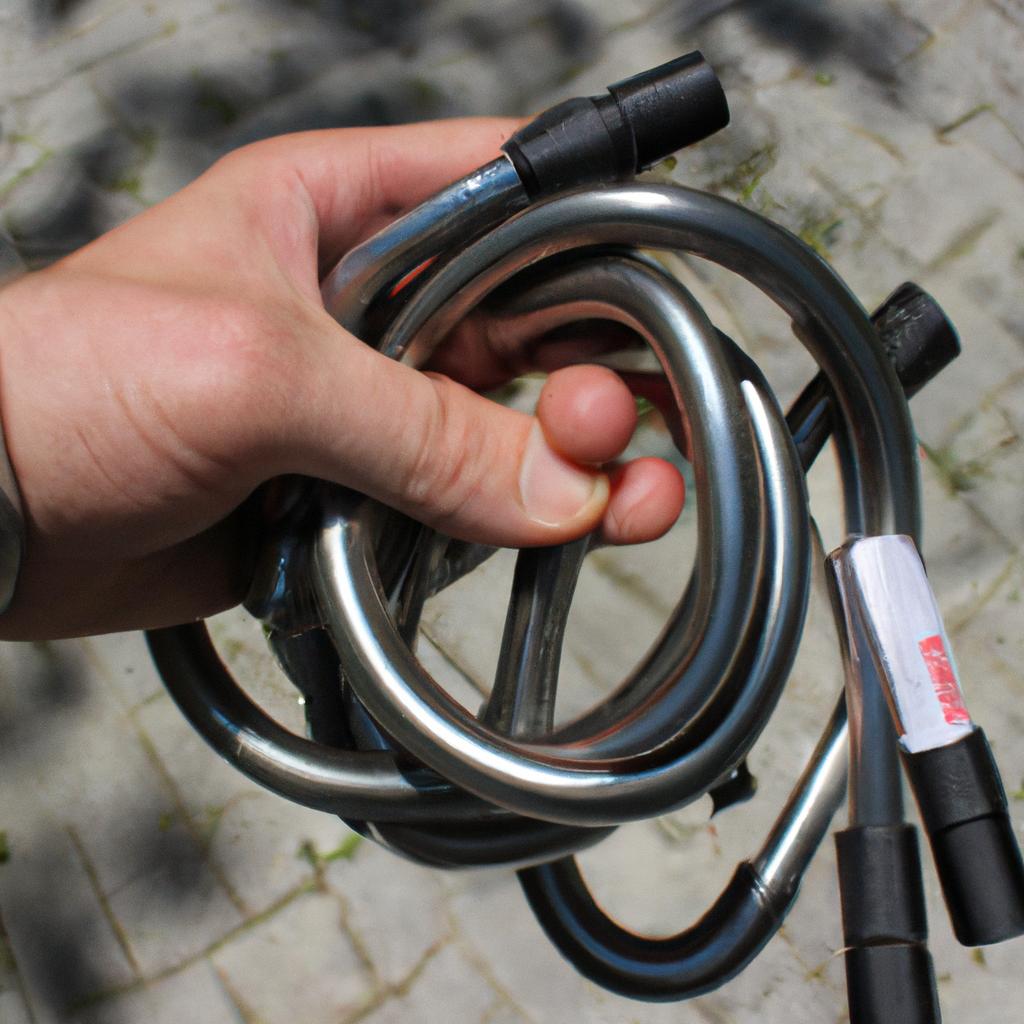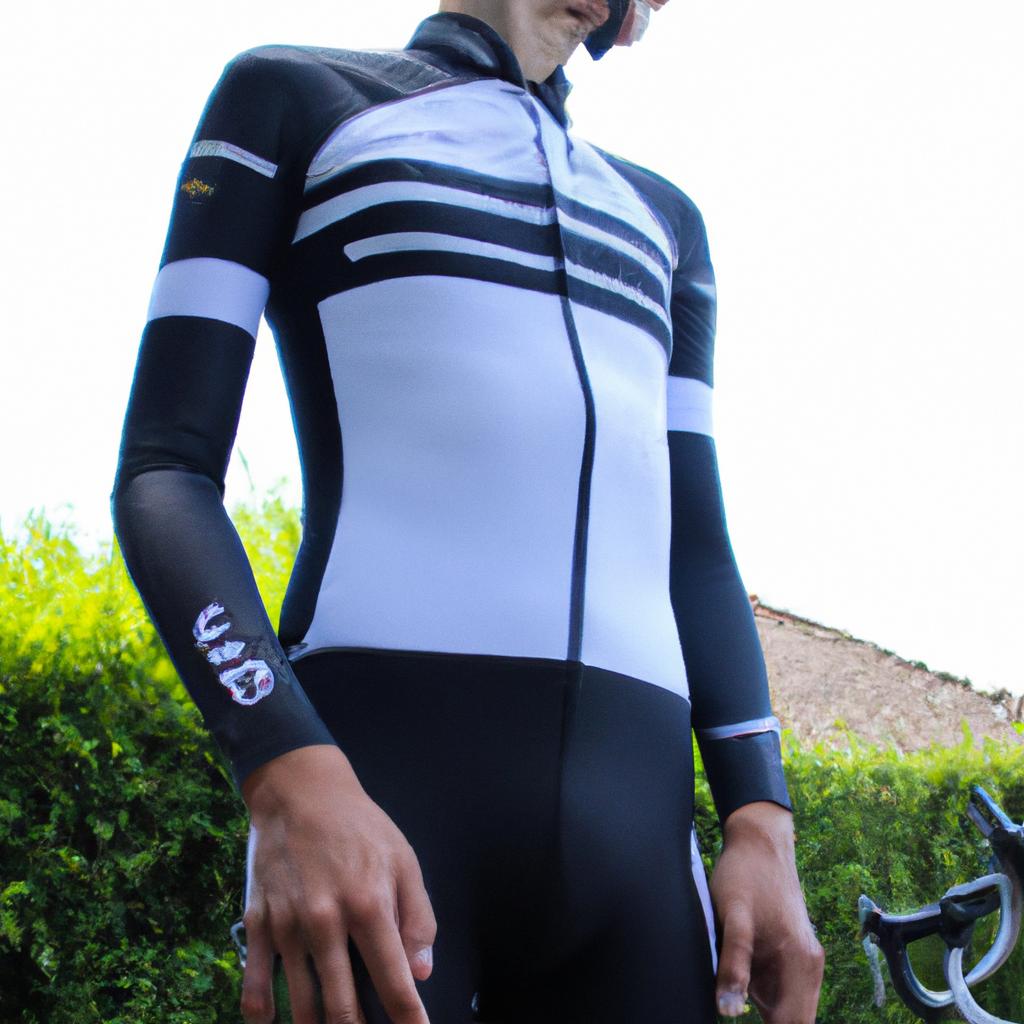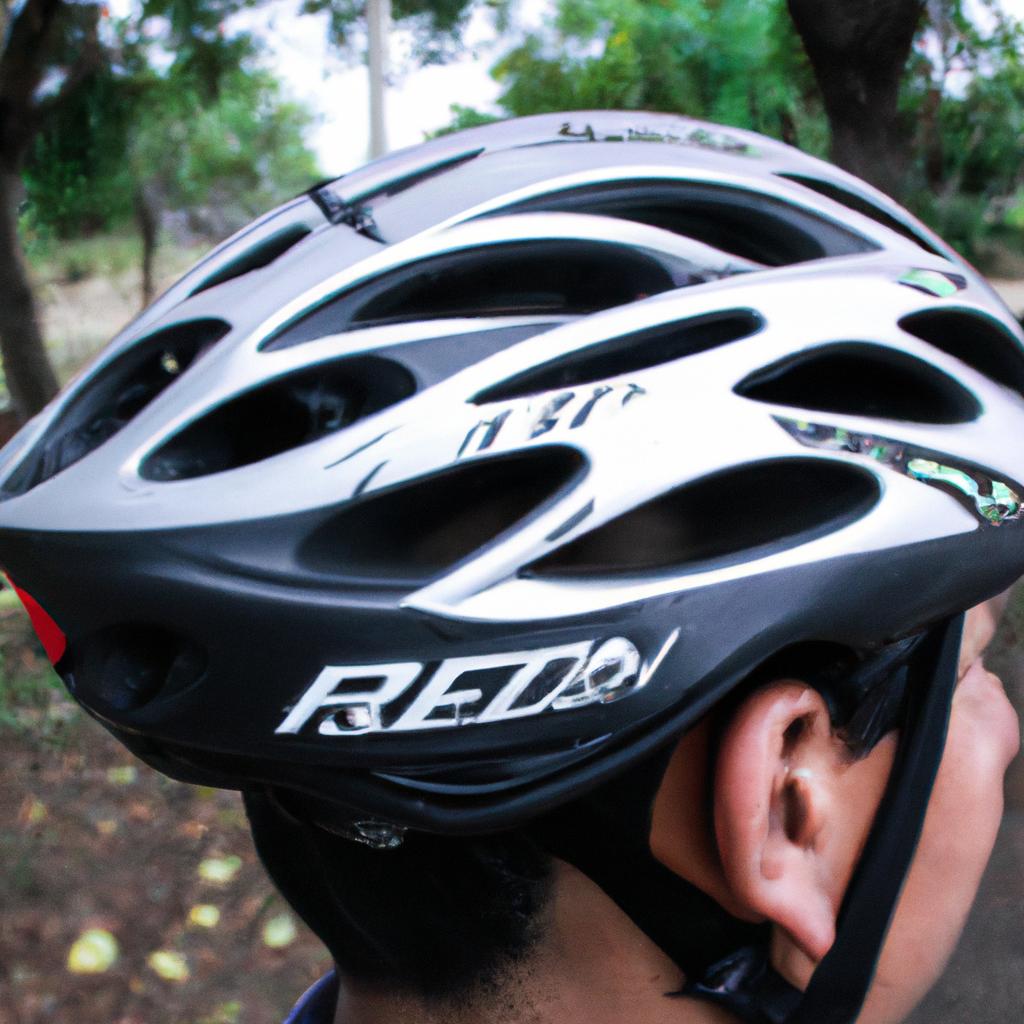Cycling Glasses: Enhancing Performance and Protection

Cycling glasses play a crucial role in enhancing performance and providing protection to cyclists. These specialized eyewear not only shield the eyes from harmful UV rays, wind, dust, and debris but also improve visual clarity, reducing the risk of accidents on the road. For instance, consider a hypothetical scenario where a professional cyclist is riding at high speeds downhill, facing strong gusts of wind that could potentially impair their vision. In such circumstances, wearing cycling glasses with wraparound frames and polarized lenses can significantly enhance visibility by minimizing glare and improving contrast.
In addition to protecting against external elements, cycling glasses are designed to optimize visual perception for improved performance. The lenses employed in these eyewear options are often made of impact-resistant materials like polycarbonate or Trivex, ensuring durability while offering excellent optical quality. By reducing eye strain caused by bright sunlight or harsh lighting conditions, these glasses enable cyclists to maintain focus during long rides, ultimately leading to better endurance and concentration.
Moreover, cycling glasses frequently incorporate innovative features such as interchangeable lenses and adjustable nose pads to cater to different weather conditions and facial structures. This versatility allows athletes to adapt their eyewear according to changing light levels or specific needs during various stages of a race or training session. With advancements in lens technology , cyclists now have access to lenses with specialized coatings such as anti-fog, anti-scratch, and hydrophobic properties. This ensures clear vision even in challenging weather conditions or when encountering water splashes or perspiration.
Cycling glasses also come in a range of frame styles and designs to cater to individual preferences and comfort. Lightweight materials like nylon or Grilamid are commonly used to reduce fatigue during long rides, while adjustable temple tips and rubberized nose pads offer a secure fit and prevent slippage.
Furthermore, some cycling glasses incorporate ventilation systems or air channels that help prevent fogging by allowing airflow behind the lenses. This is particularly beneficial during intense workouts or hot weather conditions where sweat can accumulate on the face.
It’s important for cyclists to choose cycling glasses that not only provide protection but also suit their specific needs. Factors such as lens tint, polarization, and UV protection should be considered based on personal preference and the riding environment. Additionally, it’s recommended to ensure proper fit and compatibility with helmet straps for maximum comfort and safety.
Overall, investing in high-quality cycling glasses can greatly enhance a cyclist’s performance by providing clear vision, protection from external elements, and improved endurance through reduced eye strain.
Benefits of Cycling Glasses
Benefits of Cycling Glasses
Imagine you are cycling on a bright sunny day, struggling to keep your eyes open against the blinding glare. Suddenly, you put on a pair of high-quality cycling glasses designed specifically for outdoor activities. Instantly, your vision becomes sharper, and the vibrant colors of nature come alive. This simple act not only enhances your visual experience but also improves your safety and performance on the road.
Cycling glasses offer several benefits that make them an essential accessory for cyclists of all levels. Firstly, they provide protection from harmful ultraviolet (UV) rays emitted by the sun. Exposure to UV radiation can lead to various eye conditions such as cataracts or macular degeneration in the long run. By wearing cycling glasses with UV protection, you significantly reduce your risk of developing these issues.
Secondly, cycling glasses act as a shield against dust particles, insects, and debris commonly encountered during rides. These tiny objects may cause discomfort or even injury if they enter your eyes while cycling at high speeds. With their wraparound design and impact-resistant lenses, cycling glasses create a protective barrier around your eyes, ensuring clear vision without any distractions.
Furthermore, proper ventilation systems incorporated into modern cycling glasses prevent fogging caused by perspiration or changes in temperature. Fogged-up lenses can impair visibility and compromise safety while riding. Additionally, some models feature interchangeable lenses that allow cyclists to adapt to different light conditions effortlessly.
- Enhanced visual acuity
- Protection against harmful UV rays
- Prevention of eye-related injuries
- Improved comfort through anti-fog technology
Markdown table:
| Benefit | Description |
|---|---|
| Enhanced visual acuity | Clearer vision enables better perception of obstacles and road signs |
| Protection against harmful UV rays | Shields eyes from damaging effects of ultraviolet radiation |
| Prevention of eye-related injuries | Acts as a barrier against dust, insects, and debris |
| Improved comfort through anti-fog technology | Ventilation systems minimize lens fogging for uninterrupted vision |
In conclusion, cycling glasses offer a range of benefits that enhance both performance and protection while on the road. By providing UV protection, shielding from debris, preventing fogging, and improving visual acuity, these specialized eyewear accessories contribute to safer and more enjoyable cycling experiences.
Considering the importance of choosing appropriate cycling glasses, let us now explore the factors to consider when making this crucial decision.
Factors to Consider When Choosing Cycling Glasses
Enhancing Performance and Protection: Factors to Consider When Choosing Cycling Glasses
Imagine a scenario where two cyclists are preparing for a race. Both athletes have trained rigorously, possess exceptional physical fitness, and rely on their bicycles as an extension of themselves. However, one cyclist has invested in a pair of high-quality cycling glasses specifically designed for performance and protection, while the other has neglected this crucial aspect. As they embark on their journey, it becomes apparent how significant the right choice of cycling glasses can be.
When selecting cycling glasses, there are several factors that riders should consider. Firstly, the fit is paramount; glasses that do not sit securely on the face can become distractions during intense rides or races. Additionally, comfort plays a vital role in ensuring long hours on the bike remain enjoyable and pain-free. Adjustable nose pads and temple arms contribute to achieving an optimal fit tailored to individual preferences.
Furthermore, lens technology significantly impacts both performance enhancement and eye protection. The lenses’ optical clarity determines how well cyclists can perceive obstacles such as potholes or debris on the road ahead. Anti-fog coatings prevent condensation build-up when temperatures fluctuate or sweat accumulates during strenuous efforts. Moreover, UV protection is crucial to shield eyes from harmful sun rays that may cause long-term damage.
Considering these factors collectively illuminates why investing in quality cycling glasses is essential for athletes seeking peak performance and reliable eye protection:
- A secure fit ensures distraction-free riding.
- Comfortable glasses allow for extended periods on the bike without discomfort.
- Optical clarity enhances visual perception of potential hazards.
- UV protection safeguards against harmful sun exposure.
To further illustrate the importance of choosing suitable cycling glasses wisely, let us examine a comparison using a three-column table:
| Aspect | Cyclist A (with quality cycling glasses) | Cyclist B (without cycling glasses) |
|---|---|---|
| Fit | Securely sits on the face, no distractions | Uncomfortable and prone to shifting |
| Comfort | Adjustable nose pads and temple arms | Constant discomfort and irritation |
| Optical Clarity | Clear vision for better hazard perception | Limited visibility of obstacles |
| UV Protection | Shields eyes from harmful sun rays | Vulnerable to long-term sun damage |
As we can see, Cyclist A equipped with quality cycling glasses experiences significant advantages over Cyclist B. The right choice in eyewear not only enhances performance but also provides crucial protection.
Transitioning seamlessly into the subsequent section about “Different Lens Types and Their Uses,” it is essential to explore how various lens options cater to specific needs, ensuring cyclists have a comprehensive understanding when making their selection.
Different Lens Types and Their Uses
Now that we have discussed the various factors one must consider when choosing cycling glasses, it is important to delve into the different lens types available and their specific uses. Understanding these options will allow cyclists to make informed decisions based on their individual needs and preferences.
For instance, let’s take a hypothetical case study of a professional cyclist who often trains in challenging weather conditions. This cyclist may benefit from photochromic lenses, which automatically adjust their tint according to the light intensity. With this feature, our cyclist can seamlessly transition between bright sunlight and low-light conditions without having to switch glasses or compromise visibility.
When selecting cycling glasses, there are several key lens types to consider:
- Clear Lenses: Ideal for night rides or cloudy days when maximum light transmission is necessary.
- Polarized Lenses: Reduce glare and enhance visual clarity by diminishing reflections off flat surfaces such as water or pavement.
- Mirrored Lenses: Reflective coatings help reduce brightness and minimize eye fatigue during intense sun exposure.
- Tinted Lenses: Provide varying degrees of darkness to improve contrast perception in different lighting conditions.
To further illustrate the benefits of these different lens types, we present a table highlighting their characteristics:
| Lens Type | Advantages | Disadvantages |
|---|---|---|
| Clear | Maximum light transmission | No protection against glare |
| Polarized | Reduces glare | May affect depth perception |
| Mirrored | Minimizes brightness | Limited color choices |
| Tinted | Enhances contrast perception | Less suitable for low-light |
By considering these factors and understanding the pros and cons of each lens type, cyclists can select the most suitable option for their particular riding conditions and personal preferences.
Moving forward, we will explore how cycling glasses not only provide protection but also play a crucial role in enhancing performance on the road. Understanding these benefits will further emphasize the significance of selecting the right pair of cycling glasses for an optimal riding experience.
How Cycling Glasses Improve Performance
Building upon the understanding of different lens types and their uses, let us now explore how cycling glasses can enhance performance. To illustrate this, consider a hypothetical scenario where two cyclists are participating in a race under bright sunlight conditions.
In such a situation, cyclist A is wearing regular sunglasses that do not provide any specific benefits for cycling. On the other hand, cyclist B is equipped with specialized cycling glasses designed to improve performance. As they pedal along the route, several key advantages become apparent:
-
Enhanced Visibility: Cycling glasses with high-quality lenses offer improved visibility by reducing glare from the sun or reflective surfaces. This allows cyclists to navigate safely through varying light conditions without being blinded or distracted.
-
Increased Contrast: The right lens tint can enhance contrast and make it easier to distinguish objects on the road ahead. By emphasizing certain colors while minimizing others, these lenses help cyclists spot potential hazards more quickly, such as potholes or debris.
-
Reduced Eye Fatigue: Prolonged exposure to wind, dust, and harmful UV rays can cause eye fatigue during long rides. Cycling glasses act as a barrier against these elements, shielding the eyes and preventing strain. Additionally, some models come with anti-fog coatings to maintain clear vision even in humid environments.
-
Aerodynamic Design: Many cycling glasses feature sleek designs that minimize drag and airflow resistance when riding at higher speeds. With reduced air turbulence around the eyes, cyclists can focus better on their performance without distractions caused by excessive wind buffering.
Markdown bullet point list (evoking an emotional response):
- Improved safety on the road
- Better focus and concentration
- Comfortable riding experience
- Confidence in challenging weather conditions
| Benefits | |
|---|---|
| 1 | Improved Safety |
| 2 | Better Focus |
| 3 | Comfort |
| 4 | Weather Confidence |
In summary, investing in specialized cycling glasses can significantly enhance a cyclist’s performance. By improving visibility, increasing contrast, reducing eye fatigue, and providing an aerodynamic design, these glasses contribute to a more enjoyable and efficient riding experience.
Moving forward to the next section on “Protection from UV Rays and Debris,” let us explore how cycling glasses play a vital role in safeguarding cyclists’ eyes against potential hazards.
Protection from UV Rays and Debris
In addition to enhancing performance, cycling glasses are also crucial for protecting your eyes from harmful UV rays and potential debris. Imagine a scenario where you’re racing down a mountain trail on your bike, enjoying the adrenaline rush as you navigate sharp turns and steep descents. Suddenly, a small pebble is kicked up by the rider in front of you, hurtling toward your face at high speed. Without proper eye protection, this tiny projectile could cause serious injury or even impair your vision temporarily.
To shield your eyes from such hazards, cycling glasses offer several key benefits:
-
UV ray filtration: High-quality cycling glasses often come equipped with lenses that feature built-in UV filters. This protects your eyes from the damaging effects of ultraviolet radiation emitted by the sun. Exposure to excessive UV rays can lead to conditions like cataracts or macular degeneration over time.
-
Debris resistance: The design of most cycling glasses incorporates features such as wraparound frames and snug fits to prevent unwanted particles from entering your eyes while riding. Whether it’s dust, bugs, or flying stones, these protective barriers ensure that potentially harmful objects stay out of your line of sight.
-
Reduced glare: When cycling under bright sunlight or reflective surfaces like water or snow, glare can be a significant distraction and compromise visibility. Cycling glasses with polarized lenses help reduce glare by filtering out horizontal light waves, allowing for clearer vision and reducing eye strain.
These advantages make wearing cycling glasses an essential aspect of any cyclist’s gear kit. By prioritizing both performance enhancement and eye protection simultaneously, riders can optimize their experience on the road or trail while minimizing risks associated with environmental factors.
Moving forward into our next section about “Maintenance and Care Tips for Cycling Glasses,” we will explore how to properly care for these important accessories so they can continue performing optimally throughout their lifespan.
Maintenance and Care Tips for Cycling Glasses
Enhancing Performance with Cycling Glasses
Imagine a cyclist racing down a winding road, the wind rushing against their face as they push themselves to reach peak performance. In this scenario, cycling glasses can play a crucial role in enhancing both comfort and performance. Not only do these specialized eyewear protect the eyes from UV rays and debris, but they also offer several features that directly contribute to an improved cycling experience.
Firstly, cycling glasses are designed to reduce glare caused by sunlight or other bright sources of light. This not only enhances visibility but also minimizes eye strain, allowing cyclists to maintain focus for extended periods. By reducing the intensity of incoming light, these glasses ensure clear vision even in challenging lighting conditions such as early mornings or late afternoons.
Furthermore, many cycling glasses come with interchangeable lenses that cater to different weather conditions. For instance, some lenses may enhance contrast on overcast days while others provide maximum protection against intense sunlight. The ability to adapt the lens based on prevailing conditions allows riders to optimize their visual acuity throughout their journey.
In addition to these benefits, certain types of cycling glasses have aerodynamic designs that minimize air resistance when riding at high speeds. This feature enables cyclists to maintain their speed without experiencing excessive drag due to bulky frames or ill-fitting eyewear. As a result, wearing these glasses can lead to improved overall performance and reduced fatigue during long rides.
- Increased confidence and safety through enhanced visibility
- Ability to focus solely on improving performance without distractions
- Sense of freedom and adventure knowing eyes are protected from potential hazards
- Improved endurance and stamina due to reduced eye strain
| Feature | Benefit |
|---|---|
| Glare reduction | Enhanced visibility; minimized eye strain |
| Interchangeable lens | Adaptability based on weather conditions |
| Aerodynamic design | Reduced air resistance for improved performance |
| UV protection | Shielding eyes from harmful sun rays |
In conclusion, cycling glasses not only protect the eyes but also enhance performance by reducing glare, offering adaptability to different weather conditions, and providing an aerodynamic design. These features contribute to improved visibility, reduced eye strain, and increased overall comfort during long rides. Cyclists can enjoy their journey with greater confidence while knowing that their eyes are protected from potential hazards. So why settle for anything less when you have the option to elevate your cycling experience with the right pair of glasses?

